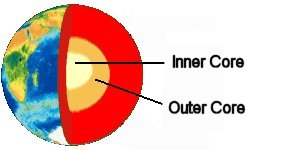
May Editorial
Earth's iron core buckles under pressure.

May Editorial
Earth's iron core buckles under pressure.
|
|
Though far from the surface of the Earth and totally unreachable by any means known to science today, the Earth’s core is vitally important to life. This core is actually two separate layers. There is an inner core which is a solid iron-nickel alloy, and a liquid outer core. (That the Earth has a solid inner core has been known since 1936. At this time the a seismologist Inge Lehmann deduced the solid core from the behaviour of earthquake-generated seismic waves as they reflected off the boundary of the Earth's inner core.) |
|
|
It is now known that the movement of the liquid outer core over this solid inner core generates the Earth's magnetic field. Without this field, solar radiation would not be deflected from the Earth, and life as we know it could not exist. Therefore the study of the Earth’s inner core is of more than academic interest. Because seismic waves propagate and pass through solid structures with ease they are the most important tool for studying the Earth's interior. Seismic waves are elastic waves of energy that move through the earth after shocks such as volcanoes and earthquakes. They are divided into waves which pass through material - body waves - and waves which travel along surfaces. The first type of waves, body waves, come in two forms. Firstly there are P-waves, which are 'pressure' or 'primary' waves. These travel through both fluid and solid materials, although they travel more slowly through liquid material. So P-waves passing through a solid are the first to appear on a seismogram as seismic waves are recorded. The second type of body waves are S-waves - 'shear' or 'secondary' waves. These are transverse waves that involve motion perpendicular to the direction of propagation. These waves are slower and appear on a seismogram later than P-waves. A useful thing about S-waves is that they only travel through solids. Since the Earth's core is inaccessible, it is not possible to collect samples to discover what is there. So until now seismology has been the only way of studying the core of our planet. Interestingly, these studies have shown that the travel time of seismic waves through the Earth's inner core isn't the same in all directions. This suggests that the inner core itself is not a uniform sphere - either the shape or the composition has some variation. A study just published in Nature Geoscience (see reference below) took a different approach to the examination of Earth's inner core. Gleason and Mao from Stanford University attempted to reproduce conditions within the Earth's inner core in the setting of a laboratory. Because the inner core is composed mostly of iron, the researchers wanted to know how iron behaves under the pressures experienced at the centre of the earth. To achieve this experimental effect, the researchers used a diamond anvil cell. This device exerts immense pressure on tiny samples, which are placed between the diamonds and squeezed. In this experiment a very small amount of pure iron was subjected to a pressure between of 200 and 300 gigapascals at room temperature. This is the equivalent pressure of 2 million to 3 million Earth atmospheres. Once the iron was under this massive pressure, changes in its structure were visualised using X-ray spectroscopy. The experiments showed that the molecular structure of iron deforms rather easily under extreme pressure. In fact this structure is about 60% weaker than was previously thought. However, the experiment was conducted at room temperature and the boundary between the inner and outer cores of the Earth are as hot as the surface of the Sun. However, at present it is not possible to simultaneously simulate both the extreme pressure and temperature in the laboratory, so the scientists had to pick one of the two conditions. To factor in the extreme temperatures, the researchers mathematically extrapolated the temperature effect from their pressure data .The ease and speed with which iron in the inner core can deform must certainly have influenced the early evolution of Earth and the development of its geomagnetic field. These latest experiments may also explain why the seismic data shows that material within the inner core is not evenly distributed. As Gleason explains, the weakness of iron might cause crystallites in the inner core to flow and line up a certain way, thus distorting the overall composition. Although iron is the main component of the Earth's inner core, it is mainly in the form of an iron-nickel alloy rather than pure iron. In future experiments Gleason and Mao are hoping to test different iron-nickel alloys to match the conditions in the inner core more precisely. They are also hoping to use lasers to heat the alloyl to the proper temperatures before applying the pressure. It is quite likely that further revelations will follow. Journal Reference:
| |
| _______________________________ | ||||
| Home | | | Shopping | | | Database |
© Biscuit Software 2004-2015
All rights reserved